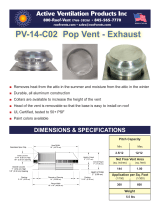
9
location of vent terminal. The plate shall
be of sufficient size to be easily read
from a distance of eight feet away, and
read “Gas Vent Directly Below”.
(b) For direct-vent appliances, mechanical-
vent heating appliances or domestic hot
water equipment where the bottom of the
vent terminal and the air intake is installed
above four feet above grade the following
requirements must be satisfied:
1. If there is not one already present, on
each floor level where there are
bedroom(s), a carbon monoxide de-
tector and alarm shall be placed in the
living area outside the bedroom(s).
The carbon monoxide detector shall
comply with NFPA 720 (2005 Edition).
2. A carbon monoxide detector shall:
a. Be located in the room that houses
the appliance or equipment;
b. Be either hard-wired or battery pow-
ered or both; and
c. Shall comply with NFPA 720 (2005
Edition).
3. A Product-approved vent terminal must
be used, and if applicable, a Product-
approved air intake must be used.
Installation shall be in strict compliance
with the manufacturer’s instructions. A
copy of the installation instructions shall
remain with the appliance or equipment
at the completion of the installation.
!
WARNING:
This furnace is not approved for installa-
tion in mobile homes. Installation in a
mobile home could cause fire, property
damage, and/or personal injury.
Location
Upflow gas furnaces are shipped ready for
installation in the upflow or horizontal right or left
positions. The *TK gas furnace is for downflow
operation only. The furnace must be installed on
a level surface, located as close to the vent (or
chimney) and as close to the center of the air
distribution system as possible. See Table 1 for
overall dimensions to determine the required
clearances in hallways, doorways, stairs, etc.
to allow the furnace to be moved to the instal-
lation point. The furnace must be installed so
that all electrical components are protected
from water. The furnace must be installed
upstream from a refrigeration system. This
furnace is not to be used for temporary heating
of buildings or structures under construction.
Clearances to Combustibles
This furnace is Design Certified by CSA Inter-
national for the minimum clearances to com-
bustible material listed in Table 3. Refer to the
furnace rating plate, located inside of the fur-
nace cabinet, for the specific model number and
clearance information.
Access for positioning and servicing the unit
must be considered when locating unit. Twenty
four inches is the minimum required clearance
from the front of the unit for servicing it. Thirty
inches is the minimum required clearance from
the front of the unit for positioning it. Thirty Six
inches is the recommended clearance from
the front of the unit. Please note that a panel
or door can be located such that the minimum
clearance on the rating plate is satisfied, but that
panel or door must be removable and allow the
appropriate clearance for your installation.
This furnace is certified for use on wood floor-
ing. This furnace must not be installed directly
on carpeting, tile, or any combustible material
other than wood flooring.
Downflow Warning (*TK Models):
The design of the downflow furnace is certified
for natural or propane gas and for installation on
non-combustible flooring. A special combus-
tible floor sub-base is required when installing
on a combustible floor. Failure to install the sub-
base may result in fire, property damage and
personal injury. The special downflow sub-
bases are factory supplied accessories, part
numbers 902974, 902677, 904108 and 904165.
904165 is an adjustable sub-base kit and it can
be used in all cabinet sizes. When the furnace
is installed on a factory or site-built cased air
conditioning coil, the sub-base is not neces-
sary. However, the plenum attached to the coil
casing must be installed such that its surfaces
are at least 1" from combustible construction.
!
CAUTION:
The downflow sub-base must not be
installed directly on carpeting, tile, or any
combustible material other than wood
flooring.




















